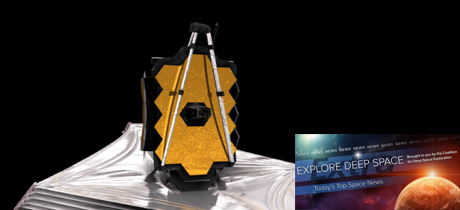In Today’s Deep Space Extra… Rogozin says Baikonur is calm despite political turmoil in Kazakhstan. JWST nails secondary mirror deployment as Hubble telescope reaches a longevity milestone.
Human Space Exploration
NASA boss Bill Nelson on a space race with China, the future of the Space Station and moreDaily Nation Today (1/5): In an interview with Time Magazine, NASA Administrator Bill Nelson offers assurances the Biden Administration has no intent of letting China reach the Moon with astronauts ahead of a return by NASA including international and commercial partners. NASA’s budget for 2023 will include details for the increased cost of establishing a sustained human lunar presence, Nelson adds along with a pledge to support International Space Station (ISS) operations through 2030.
Frank Slazer, CEO of the Coalition for Deep Space Exploration on Morning Rush Newsy
Newsy (1/4): Coalition President and CEO talks about one of the most exciting missions of 2022: “Clearly to me is going to be the launch of Artemis I. Artemis is the program that NASA is working on to take Americans back to the Moon. The program aims to take the first woman and the first person of color to the Moon, and open space to something more inclusive that it was back in the 1960s.” He adds the program is also important for eventually going on to Mars with humans, since Artemis astronauts will learn to work and live on the Moon, a world outside the Earth.
Rogozin assures Baikonur OK despite political turmoil in Kazakhstan
Spacepolicyonline.com (1/5): Kazakhstan’s Baikonur Cosmodrome serves as the launch site for Russian Soyuz rockets with cosmonauts and astronauts headed to the International Space Station (ISS). Territory just beyond provides a landing zone for Soyuz crews returning from the ISS. Russia pays its fellow former Soviet state for access. However, Kazakhstan has been undergoing a political revolt over government regulated fuel prices. Dmitry Rogozin, the head of Roscosmos on Wednesday offered assurances that Baikonur remains calm. Established by the former Soviet Union, Baikonur is also the launch site for Progress resupply missions to the ISS and other rocket payloads.
Space Science
James Webb Space Telescope nails secondary mirror deployment
Space.com (1/5): The James Webb Space Telescope (JWST) continued its march through a critical series of post December 25 launch deployments on Wednesday with the unfolding of the space observatory’s secondary mirror. One of three mirrors, the secondary mirror’s role is to collect and focus light from the still-to-be-deployed primary mirror to a third mirror that will transmit the radiance to JWST’s instrument suite. Next up is the deployment of a radiator to dispel heat from the instrumentation. Work to deploy the primary mirror is to follow.
Hubble Space Telescope just passed a stunning milestone
Cnet (1/5): As the world waits out the deployment process for the next-gen James Webb Space Telescope (JWST), it’s a good time to contemplate the achievements of the long-lived Hubble Space Telescope, which just passed a milestone in its lifespan. The telescope, which has sent back some of the most memorable views of the universe we’ve ever seen, passed the billion-seconds mark on January 1. NASA shared another astounding number connected to Hubble’s longevity: It’s made more than 1.5 million scientific observations.
Watch ‘coronal streamers’ streak off the sun in close-up video from Parker Solar Probe
Space.com (1/4): A new NASA video from the Parker Solar Probe shows coronal streamers up close for the first time, flowing past the spacecraft like interstellar fireflies. Previously, we could only catch a glimpse of streamers during solar eclipses. But with Parker specially shielded for heat-searing passes by the sun, the spacecraft has been making daring approaches closer and closer to the star, finally reaching inside the corona during an April flyby.
Other News
Space Force wants to help fund technologies to recycle, reuse or remove space debris
SpaceNews.com (1/5): The U.S. Space Force is prepared to seek out commercial solutions for removing mounting human-made debris from Earth orbit under an initiative designated Orbital Prime, according to a video announcement from Gen. David Thompson, the Space Force vice chief of space operations, on Wednesday. Proposals for the initial phase of the strategy are due February 17.
Giant hunk of Russian space junk crashes to Earth
Space.com (1/5): Persei, the upper stage of a Russian Angara A5 heavy lift rocket that launched on a December 27 test flight but shut down prematurely, made an uncontrolled re-entry into the Earth’s atmosphere on Wednesday, with an estimated three and a half tons of hardware descending into the Earth’s atmosphere and burning up before the remainder fell into the Pacific Ocean.

